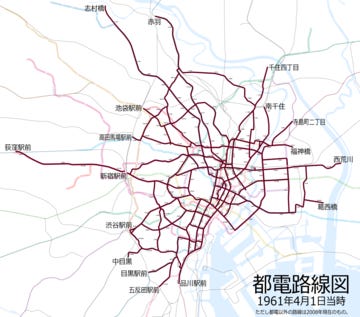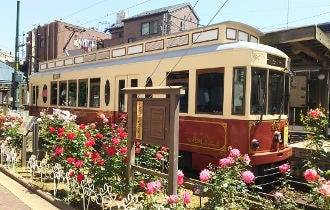Everyone always talks about Japan’s trains. Even yours truly has written articles on the wonders of the shinkansen network and Tokyo’s metro.
Yet have we been neglecting some of the other systems in place that make transportation a key pillar of life in Japan. I’m sure at some stage we’ll get to the planes, cars, and boats (not just boat racing), but I wanted to focus on the train’s less popular brother, the tram. I’ll run through their rise, them being overshadowed and removed, and the current revival. A true tram narrative arc.
Hello, Trolley!
To me, (and to a lesser extent, Wikipedia), a tram is a broad term that covers anything internal-city-transport-related that operates on streets and roads, rather than on separate train tracks. Around the world, they’re known by various names like trolleys, streetcars, light rails or LRT. This is a little controversial among the tramditionalists, who use much more specific terminology according to capacity and speed. For our purposes today, just think rail-looking vehicle that runs on the same roads as you or I.
So where did all this come from?
Way back when, there were horse-drawn carriages. In places where the normal roads were poorly designed and bumpy (1800s USA), it was impractical to actually use free-wheeling carriages that could easily go helter-skelter. They figured that it was more efficient to just have a set of rails built into the street, so that horse-pulled carriage wheels could run along them, functioning as intended, rather than proto-milkshake machines.
Thus the first tram was designed, for horses and by horses. It soon caught on, as rails were not only much smoother, but were also much easier to fix than roads. As time ticked along, there was a new horse in town. Electricity! Spreading from St Petersburg, other cities opted into the light rail sensation, and by 1895, Kyoto had their very own electric tram system. 37 years later in 1932, it was hard to find a big city in Japan without a tram network. Nationally, the tram network included 82 companies in 65 cities, with a total network length of 1,479 km.
The Trolley Problem
For Japan and much of the world, this was peak tram. Because soon enough, technology did what it always does and progressed. I’m sure you know and have strong feelings about them: please welcome the car!
The advent of the personal car meant trams became an in-between solution. Less convenient than a car taking you directly where you need to go, and slower and lower-capacity than trains, nearly everyone started phasing the tram out. Cities collectively decided that they needed more road space and less tram space. Japan was no different. The old tramlines were discontinued or integrated into other railways. By 2003, the once-mighty tramlines of Japan existed in only 19 cities.
Ok, that still sounds like a lot, but tramlines in the biggest cities from Tokyo (except for one, but we’ll get to that later), Osaka, Nagoya, all the way to Sendai and Sapporo, were all torn up and replaced by fancy subway systems. For the remaining cities that retained some tramsportation, they were often at smaller scales, and were seen more as vintage tourism options.
Keep tramming on
While trams were being phased out the pro-trammers got a new wind. The arguments among the pro-light-rail crowd have slowly become stronger as environmental and social concerns about car culture have grown. The points that are in favour of light rail are laid out below:
Cheaper than underground metros. No digging giant tunnels that frequently have unexpected delays and blow-outs in cost.
It's harder to remove than a bus system. That means the community generally keeps the light rail for several decades, rather than until the next political appointee.
Runs off electricity, so technically seen as more environmentally friendly than the fossil fuel buses/cars it would replace.
A Streetcar named Arakawa
The tram’s eventual return to triumph has been slow and gradual. However, to declare total victory, it can require capturing the leader. For Japan that means Tokyo. Where Tokyo goes, the rest of the country follows. In this instance, the LRT crowd were chasing this prized city. They wanted to prove that even in busier (busiest?) locations with high traffic requirements, there was still a use case.
The hunt to get a new light rail into Tokyo began. Or re-introduce as its own thing. Okay, fine, eagle-eyed transportation map watchers will know that Tokyo couldn’t wipe out all of the trams. You see, there were still remnants of the old Tokyo tramlines that somehow escaped the mass removal.
One sole straggler amongst the conspicuously non-metro filled landscape of the capital.
The Last of the Mohitrams, Toden Arakawa Line, has escaped the wrath of cancellation and continued its merry journey through the north of Tokyo. With its start date of 1913, the way the Toden Arakawa Line seems to have survived is through sheer nostalgia. The carriages are still from the 1950s, with mandated safety and some comfort upgrades. As others were swallowed up or removed from lack of use, the tram became more and more valued as a piece of living history. Transport nerds of the world come to visit the trams to enjoy this line which has been elevated into an icon through its survival. Of course, this is still an actual active line with commuters that prefer the slower, above ground transport options for their daily commute. It is only this now-renewed push towards light rail that has shot Toden Arakawa back into the spotlight.
As cities across the country begin to re-examine the benefits of trams and streetcars in combating congestion and environmental concerns, the continued operation of the Arakawa Line suggests that maybe it will be rejoined by others and be one of a tram network once again in Tokyo.
In fact, the neighbouring city of Utsomiya has recently unveiled their new tramsportation network. This made national news as it showed the tide may have finally turned against the decades-long removal of trams. Utsomiya’s system became the first tram network built in any Japanese city in over 75 years. It has proven successful as well, out passengering their expected milestone of 5 million riders in less than a year.
The signs are clear. Trams will rise again. From ruling the streets of Japan at the turn of the 1900’s, the environmental and social benefits may ensure that the trams are the transportation of the near future. Next time you’re in Japan, see if the trams have made it to your city!









Fond memories of growing up in Yokohama and riding the trolley everywhere in the late 60’s to early 70’s. Bring them back!
Looking forward to seeing more streetcars in Tokyo! We could use dedicated cycling paths, too…